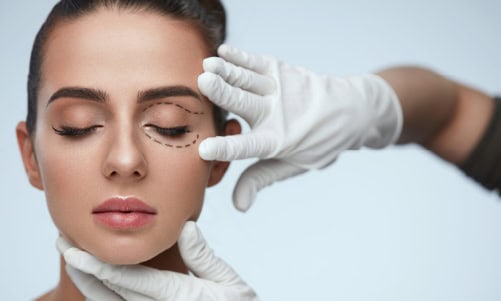- Home
- /
- Treatments
- /
- Blepharoplasty in Noida
Blepharoplasty Surgery in Noida
Eyelid surgery, or blepharoplasty, is a specialised treatment used to rejuvenate the look of the eyelids. It addresses issues such as excess skin, drooping eyelids, puffiness, and under-eye bags, providing patients with a refreshed and more youthful look. Complications like ptosis (drooping eyelids), dermatochalasis (excess eyelid skin), and festoons (swelling or bags) can be effectively corrected through this transformative surgical technique.
If you're considering a blepharoplasty, reach out to us or book a direct appointment with our plastic surgeon. At the CK Birla Hospital, we are dedicated to ensuring that your blepharoplasty is as safe, comfortable, and effective as possible. We're here to guide you every step of the way toward a successful recovery.
Blepharoplasty Surgery in Noida

What are the Risks if a Blepharoplasty is not done Timely?
If a blepharoplasty (eyelid surgery) is delayed, several risks can arise, such as:
- Visual impairment: Excess eyelid skin or fat can obstruct vision, affecting daily activities like driving or reading.
- Functional limitations: Sagging eyelids may disrupt blinking, causing eye irritation or dryness, potentially leading to corneal damage.
- Psychological impact: Dissatisfaction with appearance can impact self-esteem and mental well-being.
- Skin irritation and infections: Folded eyelid skin can trap moisture, causing dermatitis or conjunctivitis.
Delaying surgery may require more extensive procedures later, with increased risks and longer recovery times. Consulting with a specialist is crucial to determine the best timing for surgery based on individual needs and health considerations.
What are the types of Blepharoplasty?
Blepharoplasty, or eyelid surgery, encompasses several types tailored to specific needs, like:
- Upper blepharoplasty: Targets hooded upper eyelids by removing excess skin and fat.
- Lower blepharoplasty: Addresses under-eye bags and wrinkles by repositioning or removing fat and tightening the skin.
- Transconjunctival blepharoplasty: Involves internal incisions to adjust fat without external scarring.
- Asian blepharoplasty: Creates a double eyelid appearance through crease formation.
- Canthoplasty: Adjusts the outer corner (canthus) for functional and aesthetic reasons.
- Canthopexy: Provides support to maintain eyelid position.
Consultation with a specialist is vital to determine the best approach based on individual anatomy and desired outcomes. Each type of blepharoplasty offers unique benefits and considerations for optimal results.
What is the Average Cost of a Blepharoplasty?
The cost of a blepharoplasty varies as per the specific type of treatment advised by a healthcare provider, such as:
- Upper blepharoplasty
- Lower blepharoplasty
- Transconjunctival blepharoplasty
- Asian blepharoplasty
- Canthoplasty
- Canthopexy
- The cost can also vary widely depending on several factors, including the location, the extent of the treatment, the doctor’s experience, and the hospital’s pricing structure.
To get an explicit estimate for the cost of a blepharoplasty at the CK Birla Hospital, contact the hospital directly. Additionally, you can consult with our board-certified plastic surgeon to discuss your specific needs and receive a personalised quote for the treatment.
What is the Biagnosis Before a Blepharoplasty?
Before a blepharoplasty (eyelid surgery), a thorough evaluation is essential, which involves:
- Consultation with a specialist: Meet with an ophthalmologist or plastic surgeon specialising in oculoplastic surgery.
- Medical history review: Assess past eye surgeries, conditions, allergies, and overall health.
- Eye examination: Evaluate visual acuity, tear film, intraocular pressure, and eyelid function.
- Assessment of eyelid function: Check eyelid closure, position, and signs of disorders like ptosis.
- Skin condition evaluation: Assess skin quality, excess skin, wrinkles, puffiness, and sun damage.
- Visual field testing: If necessary, perform tests to assess visual obstruction by eyelid skin.
The diagnosis is based on findings from these evaluations, which may include dermatochalasis, ptosis, or eyelid bags. Treatment options, including blepharoplasty, are then discussed based on the diagnosis and the patient’s goals. This tailored approach ensures effective correction of underlying issues.
Meet our Top Plastic Surgeon Doctor

What are the Pre-treatment/Surgery Instructions for Blepharoplasty?
Before blepharoplasty (eyelid surgery), adhere to these specific pre-treatment guidelines for a successful procedure and recovery: Consultation and health assessment Meet your surgeon for a thorough consultation, discussing medical history and current medications. Undergo required medical tests to assess overall health and suitability for surgery.- Lifestyle Adjustments: Stop smoking weeks before surgery to aid healing. Avoid blood-thinning medications like aspirin and ibuprofen.
- Preparation for Surgery: Arrange transportation for the day of surgery and post-operative care. Wear comfortable clothing and ensure a recovery area is set up at home.
- Hygiene and Fasting: Follow precise pre-operative cleansing instructions. Fast (no food or water) for around 8 hours before surgery.
- Post-op Care: Learn and plan for post-operative care, including medication and follow-up appointments.Clear communication with your surgeon and adherence to these instructions are vital for a successful blepharoplasty.
What are the Post-Surgery Instructions for Blepharoplasty?
After undergoing blepharoplasty, the recovery process requires attentive care and adherence to these post-surgery instructions:- Rest and Recovery: Take ample rest and avoid strenuous activities for several days post-surgery.
- Eye Care: Use prescribed eye drops and apply cool compresses to reduce swelling and refrain from touching or rubbing your eyes.
- Medications: Take pain relievers and antibiotics as directed to manage discomfort and prevent infection.
- Follow-up Appointments: Attend all scheduled check-ups to monitor healing progress.
- Swelling and Bruising Management: Expect gradual improvement over weeks.
- Physical Limitations: Avoid bending over or lifting heavy objects.
- Protecting your Eyes: Wear sunglasses outdoors and avoid makeup until advised.
- Diet and Hydration: Maintain a nutritious diet and stay hydrated.
- Incision Care: Keep incisions clean and follow wound care instructions.
- Signs of Infection: Watch for increased redness, swelling, or fever.
How do you Recover after a Blepharoplasty?
Recovering after blepharoplasty requires careful attention to post-operative care, which includes:- Follow Doctor's Instructions: Adhere to specific guidelines provided by your surgeon for optimal healing.
- Manage Discomfort: Use recommended pain relievers and cold compresses to reduce swelling and bruising.
- Protect your Eyes: Wear sunglasses outdoors and avoid activities that strain your eyes.
- Keep Head Elevated: Sleep with your head elevated on pillows to minimise swelling.
- Use Prescribed Medications: Apply eye drops or ointments as directed to prevent infection.
- Avoid Strenuous Activities: Rest and refrain from heavy lifting or strenuous activities. Remember to attend follow-up appointments for monitoring and guidance on wound care.
Be a super-mom, stay informed about pregnancy health updates with our weekly newsletter
[contact-form-7 id=”16292″ title=”Subscribe”]
FAQs About Blepharoplasty Surgery
What is the Ideal Age for Blepharoplasty?
The ideal age for blepharoplasty (eyelid surgery) varies but is typically considered around 35-60 years old when skin elasticity and tissue condition are more suited for effective and lasting results.
Will Blepharoplasty Correct Droopy Eyelids or Sagging Brows?
Blepharoplasty primarily corrects droopy eyelids by removing excess skin and fat. However, it does not address sagging brows, which may require a brow lift for optimal correction.
Can Blepharoplasty be Combined with other Facial Procedures?
Yes, blepharoplasty can be combined with other facial procedures like a facelift, brow lift, or skin resurfacing to achieve comprehensive facial rejuvenation and aesthetic enhancement.
Are there any Non-Surgical Alternatives to Blepharoplasty for Eyelid Rejuvenation?
Non-surgical alternatives for eyelid rejuvenation include laser skin resurfacing, chemical peels, dermal fillers, and Botox injections to address wrinkles, sagging, or puffiness around the eyes.

